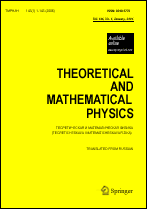|
This article is cited in 7 scientific papers (total in 7 papers)
Pentagon identities arising in supersymmetric gauge theory computations
D. N. Bozkurta, I. B. Gahramanovbcd
a Koç University, Istanbul, Turkey
b Mimar Sinan Fine Arts University, Istanbul, Turkey
c Khazar University, Baku, Azerbaijan
d Max Planck Institute for Gravitational Physics (Albert Einstein Institute), Potsdam, Germany
Abstract:
The partition functions of three-dimensional $\mathcal N =2$ supersymmetric gauge theories on different manifolds can be expressed as $q$-hypergeometric integrals. Comparing the partition functions of three-dimensional mirror dual theories, we derive complicated integral identities. In some cases, these identities can be written in the form of pentagon relations. Such identities are often interpreted as the Pachner $3$-$2$ move for triangulated manifolds using the so-called $3d$–$3d$ correspondence. From the physics perspective, another important application of pentagon identities is that they can be used to construct new solutions of the quantum Yang–Baxter equation.
Keywords:
pentagon identity, exact results in supersymmetric gauge theories, hypergeometric integral.
Received: 20.02.2018
Revised: 20.02.2018
Citation:
D. N. Bozkurt, I. B. Gahramanov, “Pentagon identities arising in supersymmetric gauge theory computations”, TMF, 198:2 (2019), 215–224; Theoret. and Math. Phys., 198:2 (2019), 189–196
Linking options:
https://www.mathnet.ru/eng/tmf9558https://doi.org/10.4213/tmf9558 https://www.mathnet.ru/eng/tmf/v198/i2/p215
|


| Statistics & downloads: |
| Abstract page: | 381 | | Full-text PDF : | 38 | | References: | 82 | | First page: | 7 |
|




 Contact us:
Contact us: Terms of Use
Terms of Use
 Registration to the website
Registration to the website Logotypes
Logotypes









 Citation in format
Citation in format 
